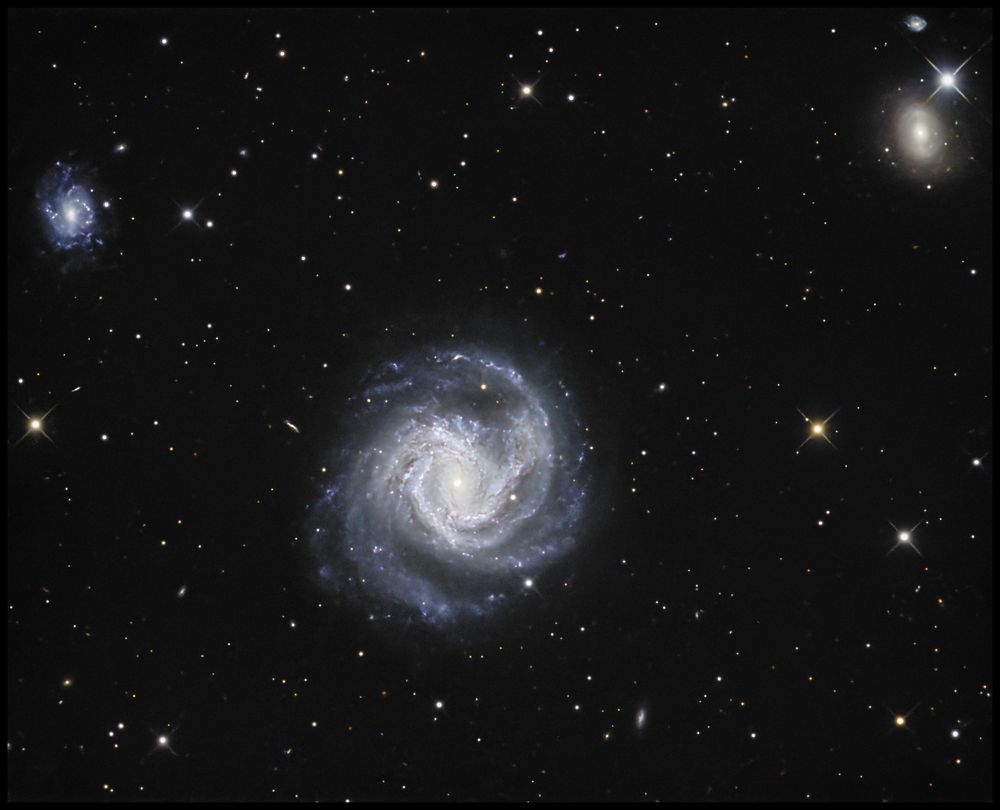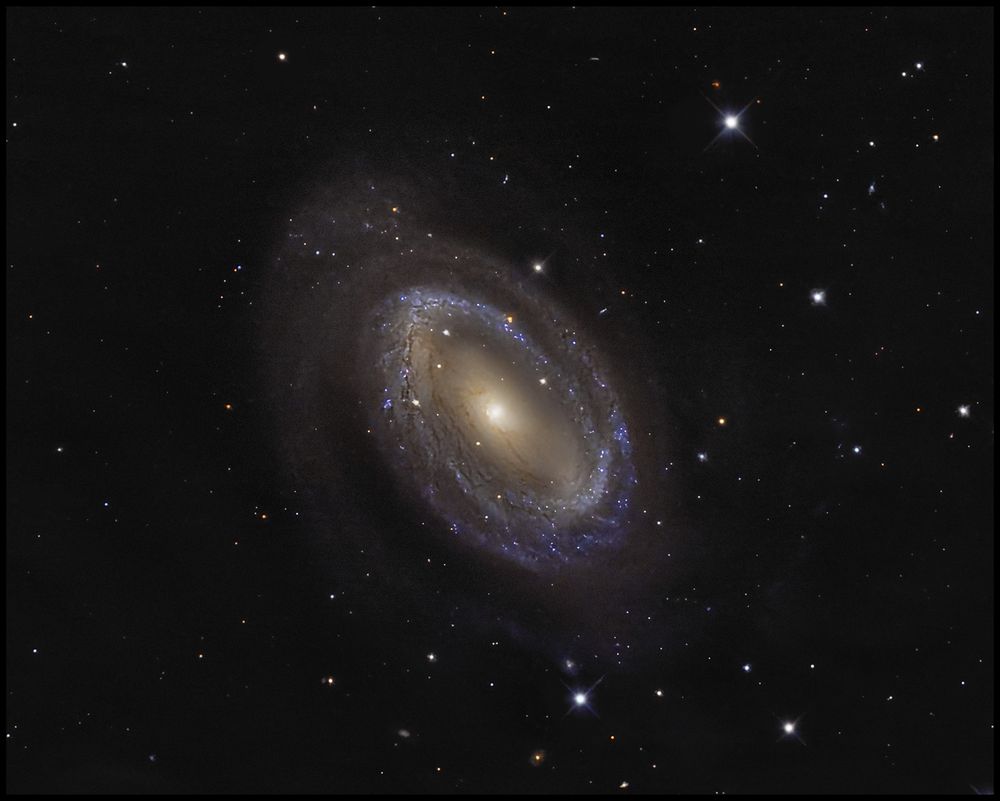
Comet C/2025 R2 (Swan)

Comet C/2025 A6 (Lemmon)
Two beautiful comets in our sky right now, C/2025 A6 (Lemmon) with its solar wind buffeted ion tail, and C/2025 R2 (Swan), currently showing a faint dust tail. Both are still getting brighter and can be easily seen in binoculars. #cloudbait #astronomy #astrophotography #comets
15.10.2025 15:37 — 👍 1 🔁 1 💬 0 📌 0
These giant content creation and delivery corporations depend upon talent. Most of which, I suspect, is strongly opposed to what's going on. The writers and techs and actors that actually generate value for these companies need to strike or otherwise stop working. Hit those companies in the $$$.
18.09.2025 18:08 — 👍 0 🔁 0 💬 0 📌 0
C/2025 N1, the comet born around another star, now zooming through our solar system, far too fast to be captured by the Sun. This is its motion over about 2.5 hours on 26 July. Only the third interstellar object ever detected. #astronomy #astrophotography #cloudbait
26.07.2025 19:58 — 👍 0 🔁 0 💬 0 📌 0
A supernova in NGC 7331 was discovered on 14 July. It's very near the galaxy core, about magnitude 17. Captured here with 80 min each RGB, animated against the same target imaged in 2022. #astronomy #astrophotography #cloudbait
21.07.2025 17:42 — 👍 0 🔁 0 💬 0 📌 0
"Shafted" in the style of Shaka Zulu and Vlad the Impaler. Hard to understand how people fail to notice that!
25.06.2025 23:15 — 👍 1 🔁 0 💬 0 📌 0

Hubble palette view of the Tulip Nebula.
Sharpless 101, the Tulip Nebula in Cygnus. Captured here in the Hubble palette, red is sulfur, green is hydrogen, blue is oxygen. Only an hour each of SHO data. #astronomy #astrophotography #cloudbait
24.06.2025 20:52 — 👍 2 🔁 0 💬 0 📌 0

Thick dust lanes forming the dark nebula Barnard 150 in the constellation of Cepheus, about 1200 light years away.
The eastern part of Barnard 150, also known as the Seahorse Nebula (this would be the head). This dark nebula consists of thick dust, inside of which new stars are forming. 6 hours each RGB (getting hard this time of year, with so few hours of dark). #astronomy #astrophotography #cloudbait
21.06.2025 16:24 — 👍 1 🔁 0 💬 0 📌 0

Globular cluster Messier 13.
M13, the biggest and best globular cluster in the northern skies. Maybe as many as a half million stars! 90 minutes each RGB. #astronomy #astrophotography #cloudbait
03.06.2025 16:30 — 👍 2 🔁 0 💬 0 📌 0

Colliding galaxies which have created long tidal tails, giving it the name the Antennae.
NGC 4038/4039, the Antennae galaxies. Tricky for me because it's very low in the southern sky, and both the top of my observatory wall and some tree branches interfere. That's what created those odd JWST-like diffraction spikes. 40 min each RGB, 60 min lum. #astronomy #astrophotography #cloudbait
24.05.2025 19:50 — 👍 4 🔁 0 💬 0 📌 0

M101 spiral galaxy, imaged as a 2x2 panel mosaic.
M101, the Pinwheel Galaxy in Ursa Major. Too big for my camera FOV, so shot as a 2x2 panel mosaic. Each panel: 60 min lum, 40 min H-alpha, 20 min each RGB. Imaged over the last two nights. #astronomy #astrophotography #cloudbait
22.05.2025 04:32 — 👍 1 🔁 0 💬 0 📌 0

M61, barred spiral galaxy in Virgo.
M61, a barred spiral in Virgo. Framed here to capture NGC4301 (upper left) and NGC4292 (upper right). 100 minutes each RGB. A few other galaxies scattered around the image, as well. #astronomy #astrophotography
04.05.2025 17:48 — 👍 10 🔁 2 💬 0 📌 0
This largely applied to W, as well (although much chaos was avoided by a functional bureaucracy). What's missing in this list, and really amplifies all of it, is "sociopathy". Incompetence tied up with malignancy is something we've never seen before. Trump revels in the pain he causes.
24.04.2025 15:27 — 👍 2 🔁 0 💬 0 📌 0

Messier 94 image showing inner starburst ring.
Messier 94, aka the Croc's Eye Galaxy. It displays an interesting ring of intense star formation near its center. 6 hours L, 45 min each RGB. #astronomy #astrophotography
20.04.2025 17:47 — 👍 3 🔁 1 💬 0 📌 0

NGC 2024, the Flame Nebula in Orion.
NGC 2024, the Flame Nebula. A rich star forming region full of glowing hydrogen and sculpted dust lanes. The blue glow at the lower right is scattered light from Alnitak, one of Orion's belt stars. 40 min each RGB. #astronomy #astrophotography
13.04.2025 15:51 — 👍 7 🔁 1 💬 0 📌 0

NGC 4676, The Mice, interacting galaxy pair.
NGC 4676, The Mice. One of the coolest interacting galaxy pairs out there. 6 hours lum, 1 hour each RGB. #astronomy #astrophotography
11.04.2025 18:02 — 👍 3 🔁 1 💬 0 📌 0
Billionaires don't need incomes, so an income tax doesn't fix anything. That's why we need an asset tax. And if they borrow against assets, that should force realization (and income taxation) of those assets.
05.04.2025 22:07 — 👍 1 🔁 0 💬 0 📌 0
It's essential math. But that said... maybe the way it's taught to those who will spend their careers applying such equations (many physicists) dictates a different teaching approach than would make sense for those who are interested in the theory (mathematicians).
04.04.2025 23:51 — 👍 2 🔁 0 💬 0 📌 0

Central Rosette Nebula in H-alpha
Rosette Nebula, central region in H-alpha. This is a four-panel mosaic made under excellent seeing conditions, an hour of exposure for each quadrant. #astronomy #astrophotography
03.04.2025 21:27 — 👍 5 🔁 1 💬 0 📌 0
If we're going to use a single descriptor, I'm inclined to go with "plutocracy" over "oligarchy". Not that they're mutually exclusive.
03.04.2025 20:57 — 👍 5 🔁 2 💬 0 📌 0

Sunrise behind Pikes Peak.
Well, a bit of snow last night, so the observatory was closed. For compensation, a beautiful sunrise this morning, coming up from behind Pikes Peak. Springtime in the Rockies. #photography
31.03.2025 01:57 — 👍 9 🔁 0 💬 0 📌 0

Central section of NGC 281, the Pacman Nebula, in the Hubble palette.
NGC 281, the Pacman Nebula. Just the central part, so the "Pacman" isn't apparent. Recently reprocessed Hubble palette image from data collected in 2023. 3 hours each [S II], H-alpha, [O III]. #astronomy #astrophotography
29.03.2025 16:56 — 👍 6 🔁 1 💬 0 📌 0
The dates given are highly speculative, from a paper that identifies apparent timing based on the orbital period of the two stars. Interesting, but very iffy. A dip in brightness was observed before the 1946 eruption, and again last year, but we're probably outside that window. So nobody knows.
27.03.2025 19:53 — 👍 0 🔁 0 💬 0 📌 0

NGC 4725, spiral galaxy
NGC 4725, a one-armed barred spiral galaxy in Coma Berenices. About 3 hours luminance and 40 minutes each RGB. #astronomy #astrophotography
24.03.2025 21:56 — 👍 12 🔁 3 💬 0 📌 0

Arp 104, Keenan's system, a pair of galaxies connected by a bridge of stars.
NGC 5218 and NGC 5216, together cataloged as Arp 104 or Keenan's system (in Ursa Major). A spiral and an elliptical bridged by some kind of tidal tail. Usually these sorts of tails are faint, but this entire system is bright, recorded here with only two hours each RGB. #astronomy #astrophotography
23.03.2025 16:31 — 👍 3 🔁 1 💬 0 📌 0

Messier 82, the Cigar Galaxy, HLRGB image.
Messier 82, the Cigar Galaxy. A nearly edge-on, distorted starburst galaxy that is ejecting large amounts of hydrogen from its center, driven by frequent supernovas. 4h H-alpha, 2.5h lum, 5h each RGB, collected in 5 sessions over the last 5 years. #astronomy #astrophotography
15.03.2025 00:12 — 👍 5 🔁 1 💬 0 📌 0

Thor's Helmet emission nebula.
NGC 2359, Thor's Helmet, emission nebula in Canis Major. 30 min each RGB + 1 hour [O III]. #astronomy #astrophotography
28.02.2025 15:17 — 👍 3 🔁 0 💬 0 📌 0

The three galaxies of the Leo Triplet.
Leo Triplet... all the parts, separate sessions; too big for my FOV. NGC 3628, 160 min each RGB. M 66, 44 min each RGB. M 65, 3 hours each RGB. Relative sizes and orientations are accurate (all are north up), but spacing between them isn't. #astronomy #astrophotography
26.02.2025 00:26 — 👍 6 🔁 1 💬 0 📌 0

M 42, the Orion Nebula.
M 42, the Orion Nebula. For such a bright object it's one of the toughest to image and process because of the huge dynamic range. This is a 2x2 mosaic of images, only 15 minutes each RGB per quadrant (3 hours total exposure time), utilizing HDR processing. #astronomy #astrophotography
22.02.2025 21:58 — 👍 4 🔁 0 💬 0 📌 0
M1, the Crab Nebula, over 22 years. First image from 2002 (with an SCT, so no diffraction spikes), second from 2024 (RC showing diffraction). And a high proper motion star in the upper right (TYC 1309-1640-1). Pretty obvious expansion. #astronomy #astrophotography
21.02.2025 00:38 — 👍 5 🔁 2 💬 0 📌 0
But... beware the learning curve! Terrible documentation and the screwiest user interface you've ever seen. But there's an active user forum that can address most problems and questions.
20.02.2025 19:51 — 👍 1 🔁 0 💬 1 📌 0






















